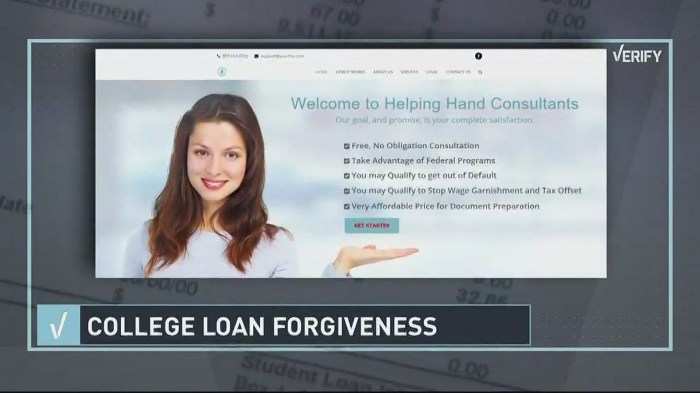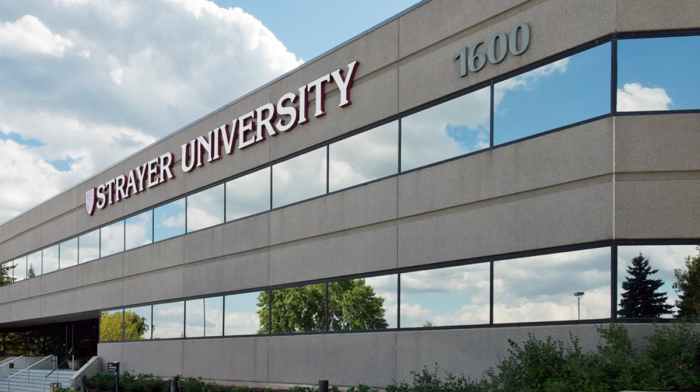
Financing a higher education can be a significant undertaking, and understanding the intricacies of student loans is crucial for prospective and current Strayer University students. This guide delves into the various financial aid options available, providing a clear comparison of federal and private loans, outlining repayment plans, and offering practical advice for managing student loan debt effectively. We aim to demystify the process, empowering you to make informed decisions about your financial future.
From exploring the eligibility requirements for different loan types to understanding the implications of various repayment plans, this resource offers a comprehensive overview of the student loan landscape specific to Strayer University. We’ll cover key terms, potential pitfalls, and strategies for successful debt management, equipping you with the knowledge necessary to navigate this important aspect of your education journey.
Strayer University’s Financial Aid Options
Securing funding for your education is a crucial step in pursuing your degree at Strayer University. Understanding the various financial aid options available can significantly ease the financial burden and allow you to focus on your studies. This section provides a detailed overview of the financial aid resources offered to Strayer University students.
Federal Student Loans
Federal student loans are government-backed loans offered through programs like the Federal Direct Loan Program. These loans are generally preferred due to their borrower protections and flexible repayment options. The application process involves completing the Free Application for Federal Student Aid (FAFSA). This form collects information about your financial situation to determine your eligibility for federal aid, including loans, grants, and work-study opportunities. Once your FAFSA is processed, Strayer University will notify you of your eligibility for federal student loans and the loan amount you’re approved for. You’ll then accept or decline the offered loan through your student portal.
Private Student Loans
Private student loans are offered by banks and other financial institutions. While they can supplement federal loans or provide additional funding, they often come with higher interest rates and less flexible repayment options than federal loans. The application process typically involves submitting an application to the lender, providing financial information, and undergoing a credit check (often requiring a co-signer if the student lacks sufficient credit history). Each lender has its own specific application requirements and approval criteria. It’s crucial to compare offers from multiple lenders before selecting a private loan to ensure you’re getting the best possible terms.
Grants and Scholarships
Strayer University offers various grants and scholarships based on academic merit, financial need, or specific affiliations. These awards do not need to be repaid. The application process varies depending on the specific grant or scholarship. Some may require a separate application, while others are automatically considered based on your FAFSA information. Checking the Strayer University financial aid website for available grants and scholarships is essential. Proactively searching for external scholarships through organizations and foundations related to your field of study can also increase your chances of securing additional funding.
Comparison of Federal and Private Student Loans
The following table compares key aspects of federal and private student loans. Note that interest rates and repayment plans can vary significantly based on the lender and loan terms.
| Feature | Federal Student Loans | Private Student Loans |
|---|---|---|
| Interest Rates | Generally lower than private loans; rates set by the government. | Variable or fixed; typically higher than federal loans. Rates depend on creditworthiness. |
| Repayment Plans | Offers various repayment plans, including income-driven repayment options. | Repayment plans vary by lender; often less flexible than federal options. |
| Eligibility Criteria | Based on FAFSA information; generally easier to qualify. | Based on credit history and income; may require a co-signer. |
| Borrower Protections | Strong borrower protections, including deferment and forbearance options. | Fewer borrower protections than federal loans. |
Types of Student Loans Available
Securing funding for your education at Strayer University involves understanding the various loan options available. Choosing the right loan depends on your financial situation, credit history, and the overall cost of your education. This section Artikels the key differences between federal and private student loans, helping you make an informed decision.
Federal Student Loans
Federal student loans are offered by the U.S. Department of Education and generally offer more favorable terms and repayment options than private loans. These loans are often preferred due to their borrower protections and flexible repayment plans. There are several types of federal student loans available to eligible students.
Subsidized and Unsubsidized Federal Stafford Loans
Subsidized Stafford Loans are need-based; the government pays the interest while you’re in school at least half-time, during grace periods, and during deferment. Unsubsidized Stafford Loans are not need-based; interest accrues from the time the loan is disbursed, even while you’re in school. Eligibility for both requires U.S. citizenship or eligible non-citizen status, enrollment at least half-time in a degree program, and maintaining satisfactory academic progress. The amount you can borrow depends on your year in school and your financial need (for subsidized loans).
- Subsidized Stafford Loans: Advantages: No interest accrues while in school; Disadvantages: Need-based, lower borrowing limits.
- Unsubsidized Stafford Loans: Advantages: No need-based requirements, higher borrowing limits; Disadvantages: Interest accrues while in school, potentially leading to a higher total loan amount.
Federal PLUS Loans
Federal PLUS Loans are loans for graduate students and parents of undergraduate students. Eligibility for a Parent PLUS Loan requires the parent to meet certain credit requirements and complete a credit check. Graduate students must meet general federal student loan eligibility requirements. Interest rates are typically higher than Stafford Loans.
- Parent PLUS Loans: Advantages: Can help cover educational costs; Disadvantages: Higher interest rates, credit check required, potential for higher total loan cost.
- Graduate PLUS Loans: Advantages: Access to additional funding for graduate studies; Disadvantages: Higher interest rates compared to Stafford loans, credit check required.
Private Student Loans
Private student loans are offered by banks, credit unions, and other financial institutions. These loans often have higher interest rates and less flexible repayment options than federal loans. Eligibility requirements vary by lender, but generally involve a credit check, co-signer (often required for students with limited or no credit history), and proof of enrollment at Strayer University. Borrowers should carefully compare interest rates, fees, and repayment terms from multiple lenders before selecting a private loan.
- Private Student Loans: Advantages: May be an option if you’ve exhausted federal loan options; Disadvantages: Typically higher interest rates, less flexible repayment options, credit check and potentially a co-signer required.
Repayment Plans and Options

Graduating from Strayer University and facing student loan repayment can feel daunting. Understanding the various repayment plans available is crucial to managing your debt effectively and minimizing long-term costs. Choosing the right plan depends on your individual financial circumstances and repayment goals. This section Artikels the common repayment options and their implications.
Several repayment plans exist for federal student loans, and the availability of specific plans might vary depending on your loan type and lender. It’s essential to carefully consider the terms of each plan before making a decision, as different plans impact the total amount of interest you’ll pay over the life of your loan.
Standard Repayment Plan
The standard repayment plan is the most common option. It typically involves fixed monthly payments over a 10-year period. While this plan offers the shortest repayment timeframe, leading to less interest paid overall compared to longer-term plans, the monthly payments can be higher. This plan is suitable for borrowers who can comfortably afford higher monthly payments and want to pay off their loans quickly.
Graduated Repayment Plan
The graduated repayment plan starts with lower monthly payments that gradually increase over time. This option can be helpful for borrowers who anticipate increased income in the future, making higher payments more manageable later on. However, it results in paying significantly more interest overall due to the longer repayment period and the accruing interest on the larger principal balance.
Income-Driven Repayment Plans
Income-driven repayment (IDR) plans link your monthly payments to your income and family size. These plans generally offer lower monthly payments than standard or graduated plans, making them attractive to borrowers with lower incomes or significant financial responsibilities. However, IDR plans often extend the repayment period to 20 or 25 years, leading to a higher total interest paid over the loan’s lifetime. Specific IDR plans include Income-Based Repayment (IBR), Pay As You Earn (PAYE), Revised Pay As You Earn (REPAYE), and Income-Contingent Repayment (ICR). The eligibility criteria and payment calculations differ slightly among these plans.
Applying for an Income-Driven Repayment Plan
Applying for an income-driven repayment plan typically involves these steps:
- Gather necessary documentation: This includes tax returns, pay stubs, and information about your family size.
- Complete the application: The application process usually occurs through the Federal Student Aid website (StudentAid.gov).
- Submit your application: Once you’ve completed the application, submit it electronically.
- Review your plan details: After your application is processed, review the details of your assigned IDR plan to ensure accuracy.
Comparison of Repayment Plans
| Repayment Plan | Monthly Payment | Total Interest Paid |
|---|---|---|
| Standard | High, fixed | Low |
| Graduated | Low initially, increasing | High |
| Income-Driven | Low, based on income | High |
Understanding Loan Terms and Conditions

Navigating the world of student loans requires a clear understanding of the terminology and implications involved. This section will clarify key loan terms and Artikel the potential consequences of loan default, alongside resources for effective debt management.
Key Loan Terms
Understanding the core components of your student loan is crucial for responsible borrowing and repayment. These terms directly impact your overall loan cost and repayment schedule.
- Interest Rate: This is the percentage of your principal loan amount charged as interest. A higher interest rate means you’ll pay more in total over the life of the loan. For example, a 5% interest rate on a $10,000 loan will result in significantly less total repayment than a 10% interest rate on the same loan amount.
- Principal: This is the original amount of money you borrowed. Your monthly payments go towards both the principal and the interest accrued.
- Loan Fees: These are additional charges associated with your loan, such as origination fees or late payment fees. These fees increase the overall cost of borrowing.
- Grace Period: This is the period after you graduate or leave school before you are required to begin making loan repayments. The length of the grace period varies depending on the loan type and lender.
Consequences of Defaulting on a Student Loan
Failing to make your student loan payments as agreed upon has serious consequences. Defaulting can result in damage to your credit score, wage garnishment, tax refund offset, and difficulty obtaining future loans or credit. In severe cases, it can even lead to legal action. The impact on your financial future can be significant and long-lasting.
Managing Student Loan Debt
Several resources and tools are available to help students manage their student loan debt effectively. These include:
- Student Loan Repayment Calculators: These online tools help you estimate your monthly payments under different repayment plans.
- Federal Student Aid Website (studentaid.gov): This website provides comprehensive information on federal student loans, repayment options, and debt management strategies.
- National Foundation for Credit Counseling (NFCC): The NFCC offers free and low-cost credit counseling services, including assistance with student loan repayment.
- Your Loan Servicer: Your loan servicer is the company responsible for collecting your payments. They can provide information on your loan terms, repayment options, and assistance programs.
Typical Student Loan Lifecycle
Imagine a timeline representing the journey of a student loan. It begins with the origination phase, where the loan is approved and the funds are disbursed to the student. Next comes the in-school period, where the student uses the funds for education-related expenses. Following this is the grace period, a temporary reprieve before repayment begins. Finally, the repayment phase commences, where the borrower makes regular payments to the lender until the loan is fully paid off. This repayment phase can involve different repayment plans, potentially extending over many years. The final stage is loan completion, where the loan is successfully paid off. This visual representation illustrates the distinct phases a student loan undergoes from its inception to its ultimate resolution.
Managing Student Loan Debt
Successfully navigating student loan repayment requires proactive planning and consistent effort. Understanding your repayment options and developing effective strategies for budgeting and managing your debt are crucial steps in avoiding default and achieving financial stability. This section Artikels practical strategies and resources to help you manage your Strayer University student loan debt effectively.
Budgeting and Managing Repayment
Creating a realistic budget is paramount to successful student loan repayment. This involves tracking your income and expenses meticulously to identify areas where you can reduce spending and allocate funds towards your loan payments. Consider using budgeting apps or spreadsheets to monitor your finances. Prioritize essential expenses like housing, food, and transportation, then allocate as much as possible to your student loans. Remember to factor in unexpected expenses, building an emergency fund to prevent falling behind on payments. For example, setting aside 3-6 months’ worth of living expenses can provide a safety net in case of job loss or medical emergencies. Consistent and timely payments are key to maintaining a good credit score and avoiding penalties.
Avoiding Student Loan Default
Student loan default has severe consequences, including damage to your credit score, wage garnishment, and potential legal action. To avoid default, maintain open communication with your loan servicer. Contact them immediately if you anticipate difficulty making payments, exploring options like forbearance or deferment. These programs temporarily suspend or reduce your payments, providing breathing room during financial hardship. Actively explore income-driven repayment plans, which adjust your monthly payments based on your income and family size. These plans can significantly lower your monthly payments, making them more manageable. Consistent contact with your loan servicer and proactive planning are your best defenses against default.
Loan Consolidation and Refinancing
Consolidating your loans combines multiple loans into a single payment, potentially simplifying repayment and lowering your monthly payment. Refinancing involves replacing your existing loans with a new loan at a potentially lower interest rate, reducing the total amount you pay over the life of the loan. However, it’s crucial to carefully compare interest rates and fees before consolidating or refinancing. Refinancing might not be beneficial if your current interest rate is already low. For example, a borrower with multiple federal loans at 6% interest might not benefit from refinancing to a private loan at 7%, even if the monthly payment is slightly lower. Thorough research and comparison shopping are essential before making a decision.
Resources for Financial Hardship
Several resources are available to students experiencing financial hardship. The National Foundation for Credit Counseling (NFCC) offers free and low-cost credit counseling services, helping you create a budget and negotiate with your creditors. Your loan servicer can provide information on hardship programs, such as forbearance or deferment. The U.S. Department of Education’s website offers valuable resources and information on repayment options and available assistance programs. Additionally, many non-profit organizations provide financial assistance and guidance to students facing financial challenges. Exploring these options proactively can help you navigate difficult financial situations and avoid default.
Ultimate Conclusion

Securing a higher education at Strayer University is a significant investment in your future. By carefully considering the information presented here on student loan options, repayment strategies, and debt management techniques, you can approach your financial responsibilities with confidence. Remember to thoroughly research all available options, compare loan terms, and seek professional financial advice when needed. Making informed choices today will positively impact your financial well-being for years to come.
Clarifying Questions
What is the difference between subsidized and unsubsidized federal loans?
Subsidized loans don’t accrue interest while you’re in school, during grace periods, or while you’re in deferment. Unsubsidized loans accrue interest from the time the loan is disbursed.
Can I consolidate my Strayer University student loans?
Yes, loan consolidation combines multiple loans into a single loan, potentially simplifying repayment. Explore federal and private consolidation options.
What happens if I default on my student loans?
Defaulting can lead to wage garnishment, tax refund offset, and damage to your credit score. It’s crucial to contact your lender immediately if you’re struggling to repay.
Are there income-driven repayment plans available for Strayer University loans?
Yes, several income-driven repayment plans adjust your monthly payments based on your income and family size. These include ICR, IBR, PAYE, and REPAYE.
Where can I find additional resources for managing student loan debt?
The National Foundation for Credit Counseling (NFCC) and the U.S. Department of Education’s website offer valuable resources and tools for managing student loan debt.
